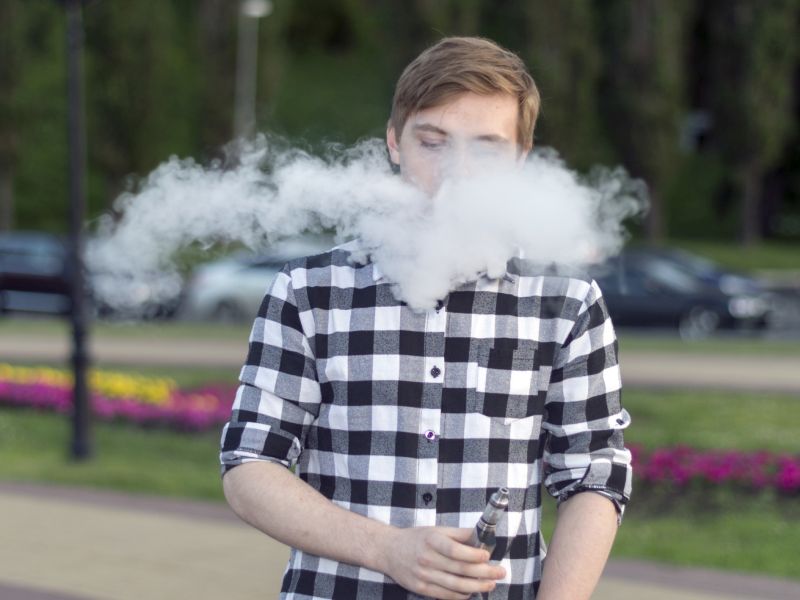MONDAY, Dec. 17, 2018 (HealthDay News) — Vaping among American teenagers increased dramatically in 2018, with nearly two of every five high school seniors reporting they’ve tried an e-cigarette during the past year, a new survey reveals.
There was a bit of good news in the report, with teens reporting decreased use of alcohol, tobacco and opioids.
But the vaping trends remained troubling. About 37 percent of 12th graders said they’d vaped within the past 12 months, compared to about 28 percent in 2017, according to the latest Monitoring the Future survey.
Vaping rates also increased by about one-third in younger teens, with about 18 percent of 8th graders and 32 percent of 10th graders reporting they’d tried e-cigarettes in 2018.
“That’s a marked increase just over a one-year period,” said Dr. Wilson Compton, deputy director of the U.S. National Institute on Drug Abuse, which funds the survey. “In fact, the investigators pointed out this is the largest increase they’ve ever seen in a substance product by youth in America,” he noted.
After alcohol, vaping is the second-most common form of substance use in the United States, the survey found.
However, marijuana use remains steady among high schoolers, with nearly 6 percent of 12th graders reporting daily use. For the past two decades, daily use among high school seniors has hovered between 5 and 6.6 percent.
“When we see rates of around 6 percent of high school seniors smoking marijuana on a daily or near-daily basis, that’s an awful lot of kids whose memory may be impaired and their brains aren’t working at full steam at the exact time when they need to be,” Compton said.
The survey has tracked drug, alcohol and cigarette use among teens since 1975. This year, 44,482 students from 392 public and private schools participated in the survey.
Most e-cigarettes contain nicotine. Early exposure to nicotine can alter the development of young brains, making teens more vulnerable to addiction throughout their lives, Compton said.
Research also has shown that teens who vape are more likely to take up cigarette smoking, he added.
“Across all the different measures of use of these new products by youth in America, we see increases,” Compton said. “We see increases in whether the kids have ever used them, whether they’ve used in the past year or the past month.”
According to Fred Muench, president and CEO of the Partnership for Drug-Free Kids, these survey results serve as a warning about “creating a generation of nicotine-dependent young people, and what that means for their self-regulation in the future.”
Responding to the rapid increase in vaping among teens, the U.S. Food and Drug Administration announced last month that it will take steps to limit or ban access to flavored e-cigarettes.
Survey results indicate this could help. One out of every four 12th graders think they are only vaping flavoring, and are unaware of the nicotine in most e-cigarettes.
Linda Richter, director of policy research and analysis at the Center on Addiction, said, “Despite what kids think, nearly all vaping products contain nicotine — high doses of it — and these products are designed to quickly and effectively foster dependence on them.”
Compton said marijuana use rates likely have remained steady due to societal acceptance of pot, as reflected in the state-level movement to legalize recreational use.
“We’ve seen a softening of the attitudes toward marijuana, and youth respond to those,” Compton said. “They have less perception of risk from use of marijuana.”
But Muench argued that, given how opinions on marijuana have shifted, it could actually be a good sign that use has remained steady among teenagers.
“We always want to see declines, but I think with the normalization and legalization and the big money behind marijuana products, steady is OK,” Muench said.
But Richter sees nothing but trouble if the legalization movement continues to gather steam.
“Increasingly relaxed regulations around marijuana are likely to push our nation’s youth in a similar direction as we’ve seen with vaping,” Richter said. “We can expect to see not only rising rates of marijuana use through vaping and other means of ingestion, but a decline in perceptions regarding the risk of harm from using marijuana.”
The survey also found that:
- Smoking is at an all-time low, with only about 4 percent of high school seniors smoking daily, compared to 22 percent two decades ago.
- Prescription opioid use (such as OxyContin or Vicodin) has declined to about 3 percent among 12th graders. Only 1.7 percent of seniors reported misuse of Vicodin in the past year, compared to 10 percent 15 years ago.
- Alcohol use also has declined. About 17 percent of high school seniors reported being drunk during the past month, down from 26 percent five years ago.
- Fewer teens report binge drinking (five or more drinks in a row). About 14 percent of 12th graders said they’d recently engaged in binge drinking, down from 17 percent in 2017, and the all-time high of 31 percent in 1998.
Compton said more progress is needed, however.
“While we see improvement overall, we still see binge drinking in way too many youth,” Compton said.
More information
The Partnership for Drug-Free Kids has more about teenagers and vaping.
Copyright © 2025 HealthDay. All rights reserved.

